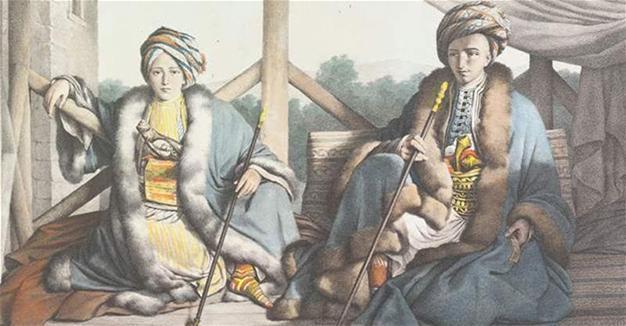Ottoman crisis in the Age of Revolutions
William Armstrong - william.armstrong@hdn.com.tr
 ‘Partners of the Empire: The Crisis of the Ottoman Order in the Age of Revolutions’ by Ali Yaycıoğlu (Stanford University Press, 347 pages, $65)
‘Partners of the Empire: The Crisis of the Ottoman Order in the Age of Revolutions’ by Ali Yaycıoğlu (Stanford University Press, 347 pages, $65)In his seminal works on the French Revolution and the Ottoman Empire, the historian Bernard Lewis argued that ideas from revolutionary France impinged on the empire but collided with civilizational walls that divided Islam from the West. “Partners of the Empire: The Crisis of the Ottoman Order in the Age of Revolutions” by Stanford University historian Ali Yaycıoğlu takes a more nuanced approach. Rethinking the Ottoman experience within the global context of the revolutionary age, Yaycıoğlu suggests that the empire at the time was also the site of reform, reorganization and negotiation among key players in Istanbul and the provinces.
 It was certainly an era of extraordinary turbulence. From summer 1806 to winter 1808, three governments fell as a result of popular riots or coups; two sultans were dethroned and strangled, five grand viziers were deposed, beheaded or poisoned; several lower ministers were dismembered by the populace; and thousands of others lost their lives. This followed decades of cultural, intellectual, and scientific vitality that Yaycıoğlu describes as a tentative “Ottoman Enlightenment” through the 18th century.
It was certainly an era of extraordinary turbulence. From summer 1806 to winter 1808, three governments fell as a result of popular riots or coups; two sultans were dethroned and strangled, five grand viziers were deposed, beheaded or poisoned; several lower ministers were dismembered by the populace; and thousands of others lost their lives. This followed decades of cultural, intellectual, and scientific vitality that Yaycıoğlu describes as a tentative “Ottoman Enlightenment” through the 18th century. The fiscal and administrative organization of the Ottoman landscape had always been a dizzying kaleidoscope. Actual imperial control over many areas nominally under Ottoman authority was weak at best. Different regions had vastly different administrative arrangements. The Ottoman state constantly negotiated and built horizontal ties with regional powerholders. Some regional actors entirely bypassed the central administration, while others rebelled to secure a better negotiating position.
By the end of the 18th century, the authority of the sultan in Istanbul had become almost non-existent outside Istanbul. Institutional reorganization was needed after decades of imperial decline and steadily mounting military and fiscal crises. The reform-minded Sultan Selim III came to the throne in 1789, and soon his supporters and leaders of other reformist factions captured key bureaucratic and military positions. At first there was hardly any consensus on how to carry out necessary changes. But before long members of the new elite came up with the “New Order” - a military, fiscal, and social agenda, adapting technological and scientific changes from the West to reinvigorate the ailing empire.
This program challenged the vested rights, socioeconomic benefits, and conventions of key sections of Ottoman society. Most importantly, the elite janissary units, numbering tens of thousands, were set fiercely against the New Order. Described by Yaycıoğlu as a “colossal socio-military group,” the janissaries found common cause with many provincial notables and regional magnates who stood to lose from the New Order. The janissaries were profoundly integrated into urban society in Istanbul and were able to mobilize popular opposition. In 1807, the New Order was brought down by that opposition and Selim III was overthrown. There was a counter coup in the summer of 1808, when a group of New Orderists took back power with support from several Balkan notables, together suppressing janissary oligarchs in Istanbul and reinstating the New Order. But in November 1808 another janissary-led popular rebellion ended this restoration.
Amid all this toing and froing, a Deed of Alliance was produced that aimed to end the crisis by bringing together the various interests in the provinces and the center. In September 1808, for the first time, regional strongmen and prominent families from different parts of the empire acted collectively and a new alliance was forged between provincial and imperial elites. The Deed of Alliance aimed to end the Ottoman political crisis through a general accord across the empire.
The Deed was collective and overarching, but it was basically an elite agreement with an oligarchic character. It also did not produce an electoral or representative system. But despite its limitations, the Deed still “had much in common with contemporary political documents in various countries that experienced different forms of constitutional and republican order,” he argues. It had limiting and participatory elements, constituting the political order as a common enterprise, assuring mutual obligations, sureties, and liabilities.
Still, the Deed of Alliance was short-lived and its implications were not ratified by successor grand viziers. There is still debate among historians about its long-term significance, but the process around its formation is certainly important. The Enlightenment political philosopher de Montesquieu shaped the image of the Ottoman Empire for generations by characterizing it as an oriental despotism, where all power was in the hands of the sultan. Austrian diplomat Franz Freiherr von Ottenfels, however, said the Ottoman regime was more like a republic, where provincial notables had a negotiating weight and where public opinion mattered, with the janissaries as its partisans. Yaycıoğlu’s close examination of these tumultuous years shows that von Ottenfels was closer to the mark. “Partners of the Empire” is also a good reminder that coups, counter-coups, purges, and bitter intrigue have a long history. There is little new in today’s Turkey.
*Follow the Turkey Book Talk podcast via iTunes here, Stitcher here, Podbean here, or Facebook here.










